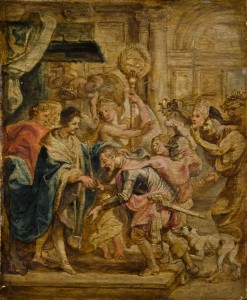
On February 26, 1622, Peter Paul Rubens was commissioned by Maria de’ Medici, The Queen Mother, to create two cycles of paintings for the Luxembourg Palace.
The first cycle was completed in 1625, but the second cycle, Life of Henry IV, experienced multiple setbacks. Over the years, Cardinal Richelieu unsuccessfully tried to give the commission to other artists. In 1628, Rubens began sketching for the cycle. In 1630, he began to paint canvases, but was told his measurements were incorrect. By 1631, Rubens still had not been told the exact measurements of the gallery, and abandoned the project.
This sketch is based on an event that took place on April 30, 1589, in the palace garden of the Château of Plessis-les-Tours. King Henry III decided to reconcile with Henry of Navarre and recognize him as heir. Rubens placed the characters in a throne room, instead of the garden. He also incorporated many symbolic motifs in the sketch. Both Henrys jointly grip the scepter of France with their right hands, which appear again in the center of a wreath atop a pole held by a winged figure. The figure, believed to represent Concord, also holds back two figures believed to be personifications of Fraud and Discord. Rubens includes the transfer of the crown from the king to his heir, even though the transfer occurred when Henry III was assassinated on August 1, 1589. Though Rubens had created roughly five canvases for the cycle, no painting based on this sketch is known.
By Megan Smith